Biography
Eng Leong Tan (SM’06) received the B.Eng. (Electrical) degree with first class honors from the University of Malaya, Malaysia, and the Ph.D. degree in Electrical Engineering from Nanyang Technological University (NTU), Singapore. From 1999 to 2002, he was a Member of Technical Staff at the Institute for Infocomm Research, Singapore. Since 2002, he has been with the School of Electrical & Electronic Engineering, NTU, where he is currently an Associate Professor. His research interests include computational electromagnetics (CEM), RF/microwave circuit and antenna design.
Dr. Tan has published more than 120 journal papers and more than 70 conference papers. He and his students received numerous paper awards/prizes including 2019 Ulrich L. Rohde Innovative Conference Paper Award on Computational Techniques in Electromagnetics, First Prize in 2014 IEEE Region 10 Student Paper Contest, Best Paper in 2014 IEEE Singapore AP/MTT Chapter Best Student Paper Contest, etc. Under his inspiring mentoring, his teams of students won numerous awards/prizes for their projects in international, regional and local contests. These include First Prize in 2014 IEEE MTT-S Student Design Contest on Apps for Microwave Theory and Techniques, First Prize in 2013 IEEE AP-S Antenna Design Contest, Best team in Android Applications in 2012 Design Innovation Project Competition (NTU), Best team in Robotics in 2011 Design Innovation Project Competition (NTU), Most Efficient Solution Award in 2007 Engineering Invention ‘N’ Innovation Challenge (among ASEAN universities), First Prize in NTU College of Engineering Hackathon 2016 on Digital Economy & Services, etc. He was the recipient of the IEEE AP-S Donald G. Dudley Jr. Undergraduate Teaching Award with citation: “For excellence in teaching, student mentoring, and the development of mobile technologies and computational methods for electromagnetics education.”
Dr. Tan has been very active in IEEE activities for many years. He has served as Chair and Past Chair for IEEE Singapore MTT/AP Chapter. He is the founding faculty mentor for AP-S and MTT-S Student Branch Chapters in Singapore. His service commitment and leadership has brought the chapter to win 2013 IEEE AP-S Best Chapter Award and 2014 IEEE MTT-S Outstanding Chapter Award. He is a member of IEEE AP-S Education Committee, and Membership and Benefits Committee, and the current Chair of IEEE Education Society Singapore Chapter. He has been actively involved in organizing many conferences, including General Chair of PIERS 2017 Singapore, TPC Chair of ICCEM 2020, APCAP 2018 (Auckland) and 2015 (Bali), as well as various key committee roles in other conferences. He was the IEEE AP-S Region 10 Distinguished Speaker 2015 and has been invited to deliver talks/demos on educational mobile apps and CEM methods at several cities in India, Japan and China. He is a Fellow of the Electromagnetics Academy and a Fellow of ASEAN Academy of Engineering and Technology.
Presentations
Revisiting Maxwell’s equations on field-potential dilemmas: Resolution, FDTD computation and enhanced learning
We revisit the classical Maxwell’s equations and some longstanding dilemmas pertaining to whether fields or potentials are fundamental for electromagnetics (EM). For >160 years there is no single physical quantity of three-component vector that can unify and describe all electrostatics, magnetostatics and electrodynamics for classical and quantum EM. In particular, recall from classical EM that the electric field vector fails to describe simple magnetostatics, while the magnetic field vector fails to describe simple electrostatics. Even with both electric and magnetic fields taken together (as six-component “electromagnetic” vector), they fail to describe some quantum-EM interactions such as Aharanov-Bohm (AB) effect. The AB effect has asserted that the fields are inadequate and only under-describe electromagnetics. It has highlighted the need of potentials comprising magnetic vector potential and electric scalar potential. Unfortunately, the potentials themselves suffer from many issues of being non-unique (gauge-dependent), non-physical, non-causal (possibly faster than speed of light) and non-measurable. For long they have been plagued with redundancy and ambiguity in choosing one gauge condition out of many, e.g. Coulomb gauge, Lorenz gauge, etc. Furthermore for computations, there is often the need to manually switch among different quantities and equations, in order to treat (differently) the problems of electrostatics, magnetostatics, electrodynamics and quantum interactions. For instance, the finite-difference time-domain (FDTD) methods based on Maxwell’s curl equations (involving only currents but no charges) cannot solve electrostatics, while their field solutions cannot be utilized directly for quantum via Schrodinger equation (involving only potentials but no fields).
For complete resolution of the above dilemmas/issues, we shall resort to the field-impulses to formulate new fundamental equations of electromagnetics replacing Maxwell’s field/potential equations. Unlike the potentials that are gauge-dependent and may not be physical nor causal, the field-impulses are like fields being gauge-independent, physically real, causal and measurable. Meanwhile, unlike the fields that are inadequate, a single field-impulse (three-component vector) can provide the complete unification and description of all electromagnetics including electrostatics, magnetostatics, electrodynamics and quantum-EM interactions. We shall discuss the FDTD methods for computation of field-impulses using universal current-impulses that can cater for all static, dynamic, steady or non-steady charges and/or currents for classical and quantum EM. Several mobile apps for technology-enhanced-learning of EM and RF/microwave circuits may also be demonstrated.
